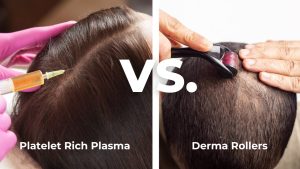Hair loss, scientifically known as alopecia, can greatly impact one’s quality of life. Finding effective treatments for this condition, such as male pattern hair loss (MPA) or androgenetic alopecia, can be challenging. However, recent research has shown promising results with the use of platelet-rich plasma (PRP) therapy in combination with microneedling and topical minoxidil. In this article, we will explore the benefits of PRP therapy, its effectiveness in promoting hair growth, and its potential as a holistic treatment for hair loss.

Microneedling and Platelet-Rich Plasma (PRP) for Androgenetic Alopecia
Microneedling is a minimally invasive procedure that involves creating tiny punctures in the skin using fine needles. It has gained popularity in treating various skin conditions like acne scars, wrinkles, and stretch marks. Recent studies have revealed its potential to stimulate hair follicles and encouraging hair growth, making it a valuable component in the treatment of androgenetic alopecia.
Exploring Platelet-Rich Plasma (PRP) Therapy:
Platelet-rich plasma (PRP) is derived from the patient’s own blood. It contains a high concentration of platelets suspended in plasma, which are rich in growth factors that promote tissue repair and regeneration. PRP therapy has been successfully used in wound healing, skin rejuvenation, and other medical conditions. In recent years, it has gained attention as a potential treatment for androgenetic alopecia, offering natural and promising results.
The Study on Microneedling and Platelet-Rich Plasma (PRP) for Androgenetic Alopecia
The study aimed to evaluate the safety and efficacy of microneedling monotherapy and a combination of microneedling with platelet-rich plasma for androgenetic alopecia. The study included thirty male patients with Hamilton Grade II to Grade V hair loss. They underwent a four-month treatment period consisting of sequential microneedling on one half of the scalp and platelet-rich plasma with microneedling on the other half.
Study Results
The study demonstrated that both microneedling and microneedling with platelet-rich plasma led to a significant increase in overall hair thickness. While the microneedling group showed a slightly higher increase in thickness, the combination group exhibited a greater increase in hair density. Although the difference between the two groups was not statistically significant, both treatments yielded positive outcomes for hair growth.
Conclusion and Recommendation
Microneedling and platelet-rich plasma (PRP) therapy offer hope for individuals struggling with male pattern hair loss and androgenetic alopecia. These treatments have shown positive results in improving hair thickness and density, leading to enhanced patient satisfaction. The combination of microneedling with PRP therapy presents a holistic approach to hair restoration.
Consultation with Experts
If you are experiencing androgenetic alopecia or any form of hair loss, it is crucial to consult with a qualified dermatologist or hair specialist. They can assess your specific case and recommend the most suitable treatment approach, which may include the use of PRP therapy. With ongoing advancements in hair restoration techniques, individuals can find hope in natural solutions like PRP therapy to increase hair density and promote hair regrowth.
Conclusion
Platelet-rich plasma (PRP) therapy, in combination with microneedling and topical minoxidil, offers a natural and effective approach to combat hair loss and stimulate hair growth. By harnessing the body’s own healing capabilities, PRP therapy can improve hair thickness and density, ultimately restoring confidence and promoting a healthier, fuller head of hair. Consultation with a qualified professional or Trichologist is essential to determine the most appropriate treatment approach for individual cases of androgenetic alopecia.
